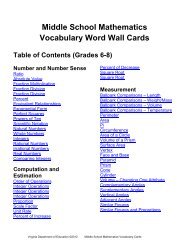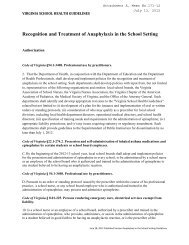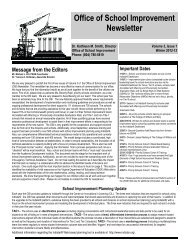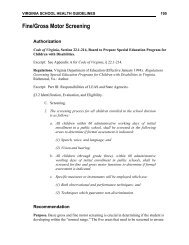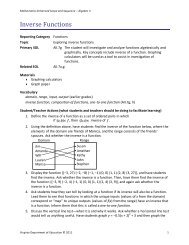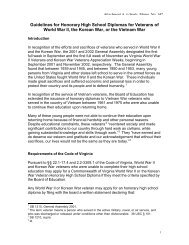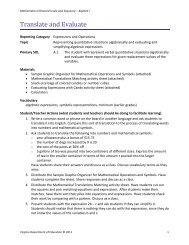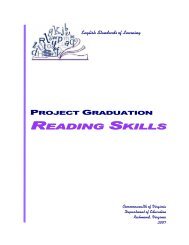What Makes Something Alive - Virginia Department of Education
What Makes Something Alive - Virginia Department of Education
What Makes Something Alive - Virginia Department of Education
Create successful ePaper yourself
Turn your PDF publications into a flip-book with our unique Google optimized e-Paper software.
Topic 6: Session 6.3 – Designer Animals<br />
Session Supplies:<br />
• Large drawing paper (enough for one sheet for each group <strong>of</strong> three to four students)<br />
• List <strong>of</strong> teacher pregenerated suggested habitats (e.g., parking lot, bowling alley, ice skating<br />
rink, swimming pool, putt-putt golf course, movie theater, a school building)<br />
• Project WILD (2006, pg. 128) “Adaptation Artistry”<br />
• Project WILD Aquatic (2000, pg. 56) “Fashion a Fish”<br />
• Variety <strong>of</strong> drawing supplies<br />
• Adaptation Project Planning sheet (pg. 181) (students will use this sheet for “Adaptation<br />
Artistry” and a second time for their project)<br />
Session <strong>Virginia</strong> SOL<br />
Science English Mathematics History & Social Science<br />
2.3 a, b, c<br />
2.7 d, e<br />
2.12<br />
2.14<br />
2.1 a, d, g, h, i, j, k, l<br />
2.5 a, b, c<br />
2.7 a<br />
Excellent resources about animal adaptations can be found on the New Hampshire Fish and Game<br />
<strong>Department</strong> (NHFGD) Web site at http://www.wildnh.com/Kids/kids.htm, Surviving in a Wild World Vol.<br />
3, Issue 1 and Wildlife in Winter Vol. 1, Issue 1.<br />
Wild Times for Kids is published twice a year by the NHFGD. The magazine can be downloaded.<br />
Session 6.3 – Designer Animals<br />
Teacher Questions & Notes<br />
-<strong>What</strong> are some <strong>of</strong> the adaptations you<br />
thought <strong>of</strong> in our last lesson?<br />
-Why do animals need adaptations?<br />
Procedures<br />
1. Review the students‟ lists <strong>of</strong> adaptations, and why animals have<br />
adaptations.<br />
2. Explain to the students that they will be creating their own<br />
pretend animal that has adapted to live in a habitat that will be<br />
given to them. They need to be creative and think <strong>of</strong> ways for<br />
their animal to meet its needs in its habitat.<br />
3. Split the class into groups <strong>of</strong> three to four students (not the same<br />
groups as their project team).<br />
4. Give each group a large piece <strong>of</strong> drawing paper and a habitat.<br />
Suggested habitats are: parking lot, bowling alley, ice<br />
skating rink, swimming pool, putt-putt golf course, movie<br />
theater, a school building, etc.<br />
5. Give each group one Adaptation Project Planning sheet.<br />
See the Project WILD activity “Adaptation Artistry” (pg.<br />
128) or Project WILD Aquatic “Fashion Fish” (pg. 56) for<br />
more information.<br />
179<br />
<strong>Virginia</strong> Animals and their Habitats<br />
Topic 6



